What's The Best Chicken Coop For Me?
Chicken Coop Buyer's Guide: The Big Considerations!
Although we pride ourselves on having the best chicken coops for sale for pretty much any type of situation, it really doesn't do you much good to know that if you don't have a clue where to begin!
If you are just starting out on your chicken raising adventure, you undoubtedly have many questions. It's important to really think about the things that are important to you now as well as in the future; otherwise, what may seem like a good investment today might turn out to be a regrettable decision later down the road.
Below, are the questions we think you should be asking yourself so that you can choose the best chicken coop for your situation. Hopefully, all of your questions will be answered. If not, definitely Contact Us. We LOVE helping people choose the right chicken coop for their home!
How Many Chickens do You Want to Raise?
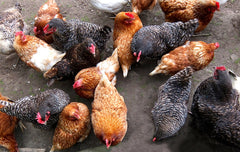 This is a super important question and not one to make a quick decision about. Although you may currently think you want only 4 chickens, it is not at all uncommon for new chicken owners to change their mind sometime down the road and expand their flock.
This is a super important question and not one to make a quick decision about. Although you may currently think you want only 4 chickens, it is not at all uncommon for new chicken owners to change their mind sometime down the road and expand their flock.
Give yourself a little wiggle room by always selecting a chicken coop that can accommodate a few more birds than you think you want to keep. It's far better to pay a little bit more for a larger coop now than to have to buy a whole additional coop sometime down the road. Besides, your chickens will appreciate a little extra space and won't be as likely to pick fights with other birds in your flock.
That said, don't give yourself too much wiggle room. Having too much space per bird can actually be a bad thing because they won't be able to generate enough body heat to keep an overly large coop warm during the colder months.
Keeping all of that at the forefront of your decision making process, here are the things you need to be looking at once you decide on the number of chickens you think you want to house:
Size of the Coop
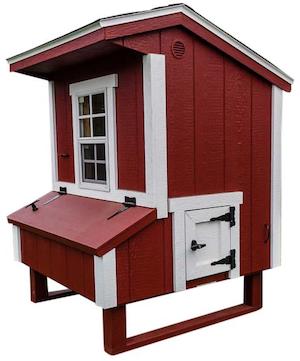 The number of chickens you want to have has a direct relationship with the size of the coop you need for them. If you cram too many chickens into too small of a space, you are sure to get a great deal of antisocial pecking between them. All depending who you listen to, each full size chicken should have 2-4 square feet of space. Always eager to compromise, I think 3 square feet is a pretty good rule of thumb. You can cut the number in half if you are planning on raising bantam chickens.
The number of chickens you want to have has a direct relationship with the size of the coop you need for them. If you cram too many chickens into too small of a space, you are sure to get a great deal of antisocial pecking between them. All depending who you listen to, each full size chicken should have 2-4 square feet of space. Always eager to compromise, I think 3 square feet is a pretty good rule of thumb. You can cut the number in half if you are planning on raising bantam chickens.
All you need to do is multiply the length by the width of the coop and then divide that number by 3 to know the maximum number of regular size chickens it can hold (or divide by 1.5 if housing bantams). Keep in mind, however, that most chicken coop dimensions are in inches, so the math is slightly more complicated because each dimension needs to be divided by 12 to get "feet" as your final answer. So, the real equation is [(length ÷ 12) x (width ÷ 12)] ÷ 3 = approximate # of standard chickens. For example, a chicken coop that is 64" L x 39" W would be 17.33 square feet and good for up to about 6 standard size chickens:
64 ÷ 12 = 5.33
39 ÷ 12 = 3.25
5.33 x 3.25 = 17.32
17.32 ÷ 3 = 5.77 (about 6 chickens)
| IMPORTANT MATH NOTE: Make sure you divide each dimension in inches by 12 first, before multiplying the length and width and then dividing by 3. If you try multiplying the length and width in inches first, before dividing by 12 and then by 3, the math doesn't even come close to being right! |
Now, it should be noted that giving your chickens a little extra space is going to decrease the number of confrontations that happen between your birds, so I guess that's where the 4 square feet advocates are coming from.
It can be as little as 2 square feet per normal size chicken if your birds are in a warm area year round (like Florida) and are free range (free to roam around your entire, well protected, fenced yard) or if you have an especially large run and live in a year-round warm climate. This is because chickens with a whole lot of run space or open yard really only need the coop for laying eggs and sleeping, which only takes up about 1 square foot per bird.
If this doesn't make the size you need crystal clear, we do have another guide on determining how much room you need per chicken here.
Number of Nesting Boxes
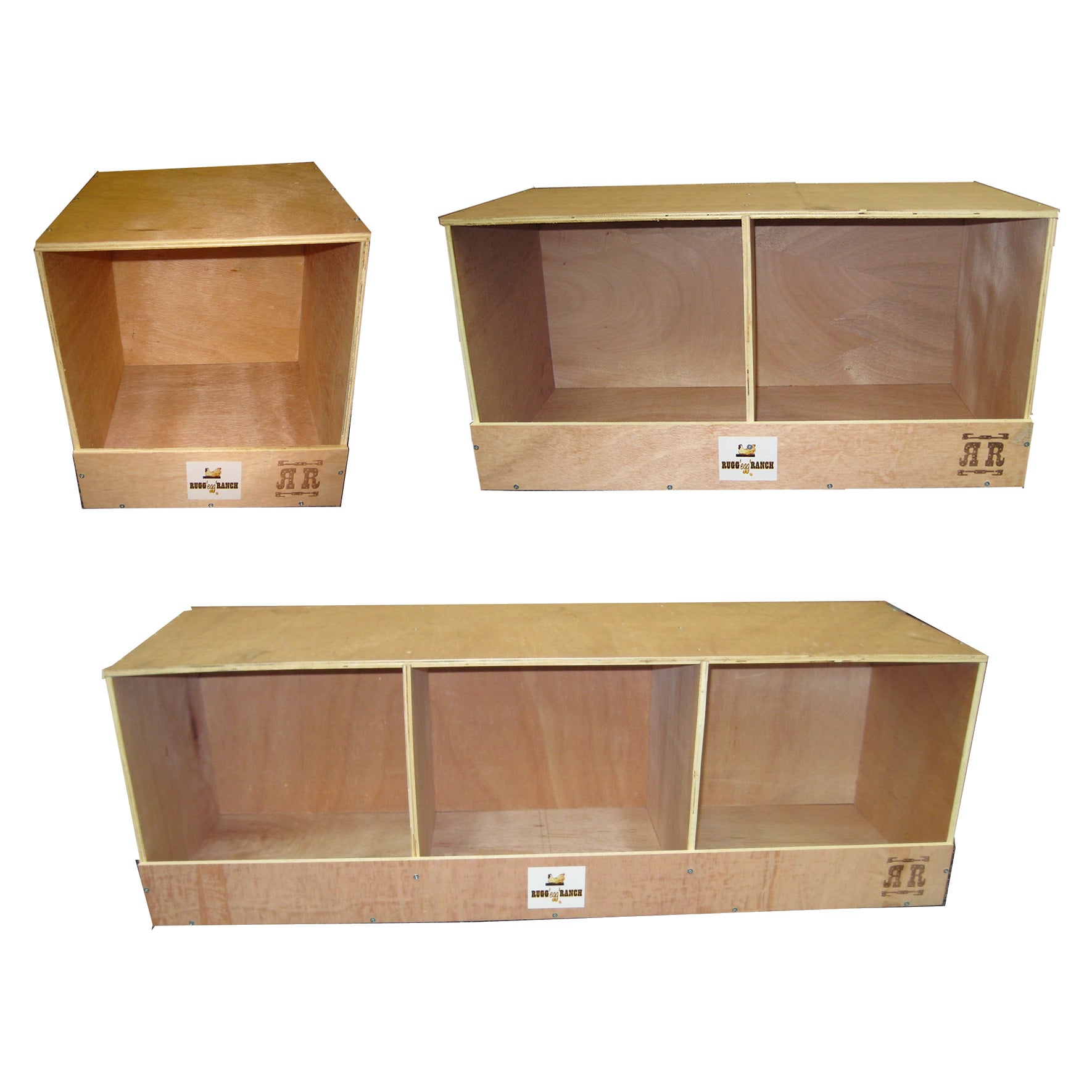 Speaking of laying eggs, hens need a place to do that. A nesting box is where hens will lay those wonderful fresh eggs, so you need to make sure that your chicken coop has enough nesting boxes for the hens that it houses.
Speaking of laying eggs, hens need a place to do that. A nesting box is where hens will lay those wonderful fresh eggs, so you need to make sure that your chicken coop has enough nesting boxes for the hens that it houses.
Fortunately, chickens innately have no problem sharing nesting boxes, so you don't need one for every single hen. You just need to make sure that there is one nesting box for every 3-4 hens (roosters don't need them, for obvious reasons). And, it doesn't matter if they are standard size chickens or bantams as far as nesting boxes are concerned.
The nesting boxes should be about 1 foot deep and can be separate or one long nesting box for multiple birds but there should be about one square foot per nesting area. So, a nesting box that was one foot deep by one foot wide by three feet long would be enough for 9-12 hens.
Length of Chicken Roosts
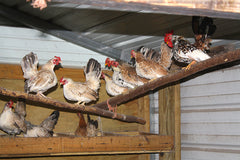 You know how grumpy you are when you don't get any sleep and how you don't feel like doing anything the next day. Chickens are the same way. They need their sleep if you want them to live happy, healthy and productive lives.
You know how grumpy you are when you don't get any sleep and how you don't feel like doing anything the next day. Chickens are the same way. They need their sleep if you want them to live happy, healthy and productive lives.
Chickens sleep on roosts, so it is important that there is enough roosting space for all of your birds. You can get away with as little as 8 inches of roosting space but 1 foot per chicken is the preferred standard.
Really, this is the most important thing of all when determining how many chickens a coop can hold, since if you have a run - especially one that is protected from rain and snow - chickens will pretty much only use the coop to lay eggs and sleep.
A Final Note About Chicken Coop Size ...
We have further subdivided our Chicken Coops category by brand name as well as the number of birds the manufacturers say their coops can hold. Some manufacturers are a little optimistic in their chicken coop capacity assessments, so don't take their word as gospel. Make sure to note the square feet of a coop (length in feet x width in feet divided by 3) to get a pretty good idea on the true number of standard size happy chickens it can house.
Don't forget to count the nesting boxes and roosting space, too. Those things often do not match up well with the coop size. Whichever leads to the smallest number of birds for any given coop - the coop area, its number of nesting boxes or the amount of roosting space - is the number you should go with.
Again, as mentioned above, the roosting space might be the most important thing of all. Except in bitter cold weather, if you have a covered chicken run attached to your coop that can accommodate a large number of birds, you really only need to make sure that there is enough roosting space in the coop for your chickens to sleep and, to a lesser extent, that there are enough nesting boxes to lay eggs.
How Many Chickens Can the Run Hold?
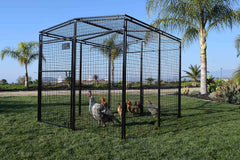 Chickens like to get their exercise and not be cooped up all day (I guess you know where that phrase comes from now). If you want your chickens to remain in a safe area, away from predators, they need to be protected from birds of prey, above, and on all sides from other animals that would make a delicious meal of your birds. Plus, chickens need daylight. When they don't get it, their egg production can drop off dramatically, so the more light they can get, the better!
Chickens like to get their exercise and not be cooped up all day (I guess you know where that phrase comes from now). If you want your chickens to remain in a safe area, away from predators, they need to be protected from birds of prey, above, and on all sides from other animals that would make a delicious meal of your birds. Plus, chickens need daylight. When they don't get it, their egg production can drop off dramatically, so the more light they can get, the better!
Chicken runs provide an excellent, safe place for your birds to forage, spread their little wings and enjoy the daylight. But, just like with chicken coops, you need to have enough space in your chicken run for your birds. The general consensus is that standard size chickens should have about 8 square feet per bird (again, half that for bantams).
Again, we have subdivided our Chicken Runs category by brand name as well as the number of birds the manufacturers say their runs can hold. And again, some manufacturers are a little optimistic in their chicken run capacity assessments, so make sure to note the square feet of a run (length in feet x width in feet) and divide by 8 to get a pretty good idea on the true number of standard size chickens it should accommodate.
A Final Note About Chicken Run Size ...
It should be noted that some chicken coops provide so much light and space, they can get away with smaller attached runs. You're going to need to factor the chicken coop size in along with the run in some instances.
Do I Want a Stationary or Mobile Coop?
 A lot of people value their yards and it's not easy maintaining green, weed-free turf. Chickens can do a whole lot of damage to yards, turning them into nothing but a bare spot if your coop and outdoor area for them (whether it is in a run or not) are in the same spot for too long.
A lot of people value their yards and it's not easy maintaining green, weed-free turf. Chickens can do a whole lot of damage to yards, turning them into nothing but a bare spot if your coop and outdoor area for them (whether it is in a run or not) are in the same spot for too long.
You can easily prevent permanent carnage to your lawn by moving the coop (and run) every few days. Of course, some coops and runs are quite bulky and heavy, so moving them is no easy task. That is, unless they have wheels on them.
A "chicken tractor" is the term often used for a coop that you can move around with wheels. Technically speaking, though, a "chicken tractor" is a chicken "coop" with no bottom or a wire mesh bottom that can be moved with wheels (sounds like the definition of a chicken run with wheels, to me). By that definition, no enclosed chicken coop with a floor could ever be considered a chicken tractor. That said, most people call any coop that has wheels a "tractor", even though it may not meet the technical definition.
If you value your lawn, you definitely should consider getting a chicken coop with wheels and if there is a run, you need wheels for that, too. For coops and runs where you can add wheels, you can usually select either two or four wheels. With a two-wheel setup, you are going to need to lift the coop a little before it is on its wheels and then you can move it wheelbarrow-style. No lifting at all is required if your chicken coop or chicken run has four wheels; you can move a 4-wheel coop or run like you would a wagon.
Provided the land is fairly flat, most of these can be easily moved by one person by simply pulling the coop or run with the included handles. Some very large and heavy coops, however, may require at least two people to move. If you have a rideable lawn tractor or small ATV, they can often be a big help when moving one of the really large coops.
A Special Note About Movable Chicken Coops on This Website
We have only listed true chicken tractors in our Chicken Tractors category but there are many chicken coops and chicken runs listed on our site that have options for adding wheels to them.
All chicken coops and runs from OverEZ® have an option for adding wheels to them. So, if you want to go with the more loose definition of a chicken tractor, you could say that the majority of the chicken coops listed on this website can also be "chicken tractors".
Can a Run be Easily Added?
Some chicken coops and runs are constructed to fit together perfectly. Those are really the best chicken coop with a run options. In these cases, the run and the coop will be from the same manufacturer. It is important that your run and coop mesh precisely; otherwise, you'll have gaps that predators can take advantage of.
All of the chicken coops on this website that have a matching chicken run have those runs listed as add-on options on the product pages.
What Type of Climate Do You Live in?
 Nobody wants to live somewhere where they are freezing in the winter or sweating to death in the summer and chickens are no different. Make sure that the chicken coop you select is ideal for the area in which you live.
Nobody wants to live somewhere where they are freezing in the winter or sweating to death in the summer and chickens are no different. Make sure that the chicken coop you select is ideal for the area in which you live.
If you live in a climate that is prone to harsh winters, you may want to look for a chicken coop that can be placed up against a building so that it is protected from chilling winds. You can also install an electrical package so that you can plug in a heater if things get too cold.
If you live in an especially hot climate, you'll want to locate your coop in a shady area of your property, so be sure that the coop can fit under any area that will be providing shade (like a tree). Again, installing an electrical package makes it possible to plug in a fan, which can cool things off quite a bit.
Finally, don't forget about rain and snow. Your chickens still need to get out of the coop on those days, so having a chicken run with a cover or roof over it is ideal.
What Is the Chicken Coop Made of?
Most chicken coops are made of wood but how good the wood is, whether or not it is pressure treated and how well it is made can have a dramatic effect on how well and how long your chicken coop holds up to the elements.
As with most things in life, you get what you pay for. The best made wooden chicken coops always seem to be built by Amish wood workers or Amish-trained craftsmen. On this website, those would be the chicken coops from OverEZ®.
An alternative to a wood coop would be a chicken coop made out of durable plastic. Now, before you cruise on by this paragraph without giving it a second thought, plastic chicken coops are amazing! They are very easy to keep clean and they can last much longer than most wood coops. Check out our high-quality plastic coops by Snap Lock here.
Can I Customize the Chicken Coop?
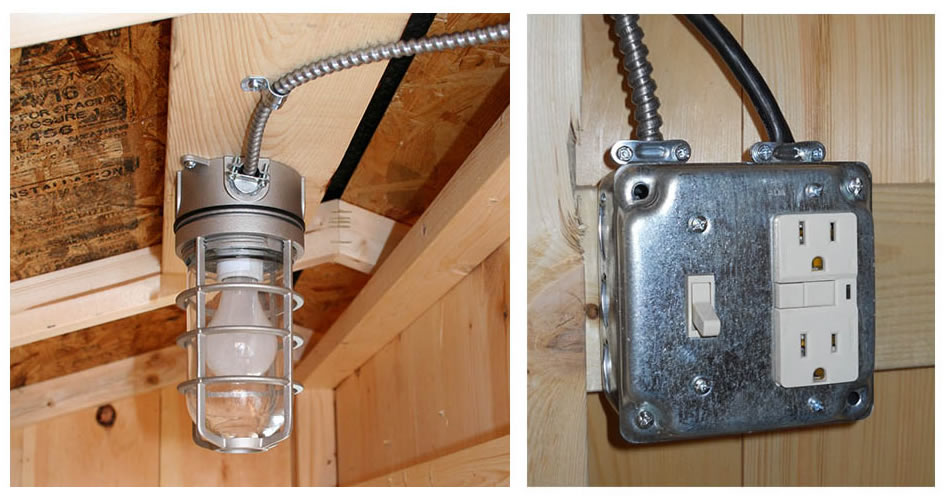 Some manufacturers specialize in chicken coops only. Some make chicken coops and chicken runs. What you see is what you get. Others offer a degree of customization, allowing you to add extras to their coops. On this website, the most customizable chicken coops are from OverEZ® and Snap Lock.
Some manufacturers specialize in chicken coops only. Some make chicken coops and chicken runs. What you see is what you get. Others offer a degree of customization, allowing you to add extras to their coops. On this website, the most customizable chicken coops are from OverEZ® and Snap Lock.
With OverEZ® chicken coops in particular, you have the option of adding a perfectly matched chicken run, an automatic chicken door, an electrical and lighting package, wheels to the chicken coop and/or chicken run as well as a canvas top to your chicken run to keep your hens cools and dry. If you want the best chicken coop design, why not have compete control over it yourself?
Do You Want a Chicken Coop Kit or a Fully Assembled Chicken Coop?
Some people are handy, some aren't. Some people love building things and others consider it a hassle. The type of person you are may dictate the chicken coop you buy.
If you don't feel like lifting a finger, represse.top may not be the place for you. All of the products we sell are in kit form so you will have to assemble them yourself.
Snaplock Chicken Coops are a breeze to put together! There are no tools required and assembly can happen in less than 30 minutes. You literally snap & lock pieces together for assembly (like the name suggests).
The next best thing is a chicken coop from OverEZ®. Their coops come in kit form on a pallet. They are deposited at the curb and it is your responsibility to get it from there to wherever you want it in your yard - one reason we highly recommend adding wheels to your OverEZ® chicken coop!
How Easy is it to Clean the Chicken Coop?
 There's no two ways around it ... chickens are messy! How easy a chicken coop is to clean is certainly a factor worth considering.
There's no two ways around it ... chickens are messy! How easy a chicken coop is to clean is certainly a factor worth considering.
Some of the chicken coops on this website have slide out trays or options where you can add them to the coop. This makes cleaning the really bad stuff easy - just slide the tray out, rinse it off and slide it back in.
The entire coop, itself, is going to need to be cleaned from time to time, which most people do by just extending a broom and/or mop or by spraying/pressure washing them. In almost all cases, the coops are small enough that you never have to go inside to do that. Of course, if you have an especially tall chicken coop, it's even easier to just walk inside and give it a real, thorough cleaning.
How Easy is it To Gather Eggs?
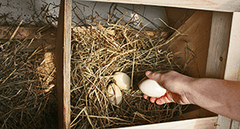 Most people raising chickens are doing it so that they can have a constant supply of super fresh eggs. If you have to bend, stretch and reach to get those eggs, it's not very convenient and you could also break a few in the process (something that is not fun to clean up, incidentally).
Most people raising chickens are doing it so that they can have a constant supply of super fresh eggs. If you have to bend, stretch and reach to get those eggs, it's not very convenient and you could also break a few in the process (something that is not fun to clean up, incidentally).
You'll definitely want to see if a chicken coop has a hinged lid above the nesting areas. It makes gathering all of those delicious eggs so much easier and you will be far less prone to damaging them. Fortunately, every single chicken coop on this website has a hinged lid above the nesting boxes, so it's something you never will have to worry about with any of our chicken coops!

